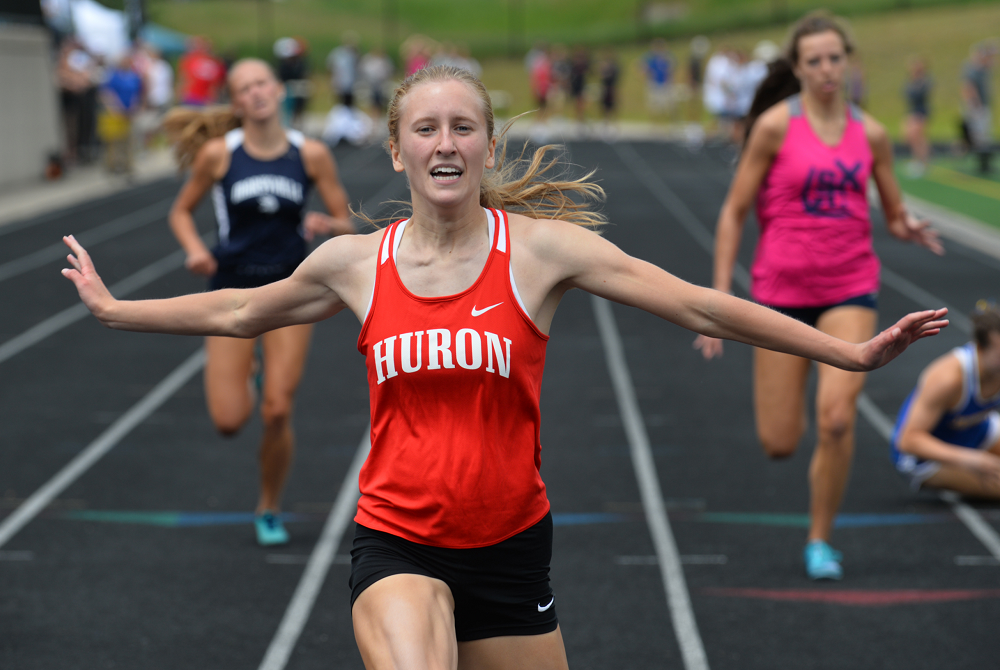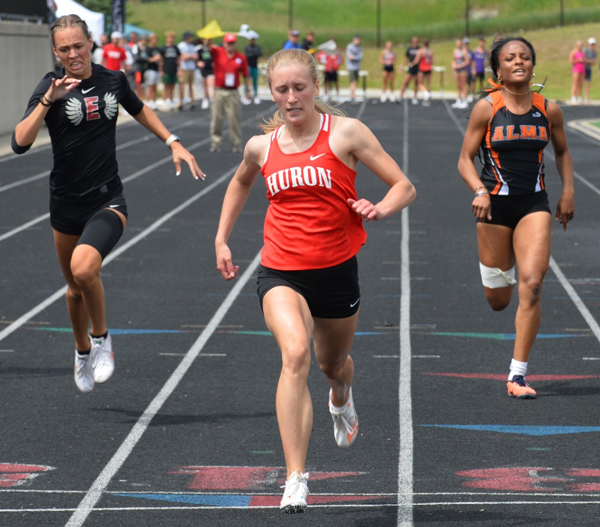
Lakes Begin 'to Bring the Legacy Back'
By
John Vrancic
Special for MHSAA.com
June 4, 2017
KINGSFORD — The Lake Linden-Hubbell girls ended a lengthy title drought Saturday, earning top honors at the Upper Peninsula Division 3 Track & Field Finals.
Lake Linden scored 110 points to secure its first title since 1983, when it was competing in Class D. Pickford squeezed past Cedarville by less than a point for the runner-up honor, and Bark River-Harris took fourth.
“We’re trying to bring the legacy back,” said junior Laura Lyons. “Mr. G (coach Gary Guisfredi) is doing everything he can to help us carry on the program.”
Lyons led the Lakes by taking the 200-meter dash in 27.53 seconds, long jump at 15 feet, 5 inches, and by helping the winning 1,600 relay (4:23.23) and placing second in the 400 (1:01.37).
In the 400, she was runner-up to DeTour senior Sarah Bailey (1:00.52).
“I think my starts were pretty good,” said Lyons. “I was in lane 8 in the 200, which made it hard to see the other girls.
“I didn’t know Sarah before today. Track is also a social event. Everybody’s just so friendly.”
Lake Linden’s Mariah Wilmer won the 800 in a school-record 2:27.08, followed by Bailey (2:28.59) and Rock Mid Peninsula eighth-grader Daisy Englund (2:35.71).
Wilmer also helped the winning 800 (1:54.99) and 1,600 relays.
Jamie Hendrickson provided the Lakes with firsts in high jump at 5-1 and by helping the winning 400 (54.10) and 1,600 relays. Sienna Anderson added a victory in the 100 hurdles (17.55).
 Pickford’s Clare Cottle won pole vault (8-6), and Cedarville’s Mackenzie Barr won discus (103-10), edging Ontonagon’s Holly Wardynski by 6½ inches.
Pickford’s Clare Cottle won pole vault (8-6), and Cedarville’s Mackenzie Barr won discus (103-10), edging Ontonagon’s Holly Wardynski by 6½ inches.
In addition to her victory in the 400, Bailey was runner-up in the 800 (2:28.59) and fourth in the 200 (28.22).
“I think that was my best time (in the 400),” said Bailey, who plans to play volleyball at Lake Superior State University this fall. “I had a pretty good start and tried to get toward the front. I had never seen (Lyons) before, but she was a good motivator. It’s always a challenge when you come here because you never know what you’re going to get.”
BR-H sophomore Hailee Demers took the 100 dash (13.30) and 300 hurdles (49.46) and placed second in the 200 (27.68). Junior teammate Jaelin Lockwood was second in the 100 (13.59) and long jump (15-4).
Dollar Bay senior Cami Daavettila won the 1,600 (5:41.78), and Chassell’s Lela Rautiola took the 3,200 (12:47.38).
“I was pleased with my time in the 1,600,” said Daavettila. “The weather was perfect for the mile and I got a PR (personal record). There was a little bit of a breeze, but nothing to hold you back.”
Engadine junior Ashtyn Buss took first in shot put (36-3) and fourth in discus (95-7).
PHOTOS: (Top) Lake Linden-Hubbell’s Lily Kumpula takes off during her leg of the 400 relay. (Middle) DeTour’s Sarah Bailey completes her championship dash in the 400. (Photos by Cara Kamps.)

Multi-Sprint Champ Racing to Finish Huron Career Ahead of the Rest Again
By
Keith Dunlap
Special for MHSAA.com
May 25, 2023
NEW BOSTON – If there was one thing Elizabeth Anderson took pride in elementary school, it was simply showing that she could outrun everyone in sight.
 In fact, Anderson has an explanation for all the success she had in those playground races.
In fact, Anderson has an explanation for all the success she had in those playground races.
“Dominance when you are in elementary school,” Anderson quipped. “I don’t think I ever had a nickname. I just think everyone knew I was fast.”
Years later, pretty much everyone who follows track & field in the state of Michigan can attest to that.
A senior for New Boston Huron, Anderson has been faster than most other competitors in the state during her three-year high school career (with her freshman season in 2020 canceled due to COVID-19).
Last year, Anderson won titles at the Lower Peninsula Division 2 Finals in the 200-meter (25.07) and 400-meter (56.28) dashes, and was runner-up in the 100-meter dash (12.23).
Often, top sprinters focus on one or two of those three races. But Anderson is certainly a different breed of sprinter because she does all three.
In fact, she holds school records in all three of those events, and if all that weren’t enough, Anderson is a part of all three sprint relay teams.
“It is hard to give her events off,” said New Boston Huron head girls track coach Danielle Lobato.
Despite the different styles the 100, 200 and 400-meter dashes present, Anderson said there usually isn’t much adjusting when she goes from one of those races to another.
 The strategy is simply, “Let’s beat the other girls to the finish line.”
The strategy is simply, “Let’s beat the other girls to the finish line.”
“I don’t really go into each race changing up how I would run,” she said.
While enjoying and succeeding in all three races, Anderson said she actually does have a favorite among them.
“I would say the 400 is probably my favorite,” she said. “Even though it hurts, it’s satisfying to see how much you can get your time down in the 400 compared to any other race.”
Anderson said she started running track in sixth grade, but really got serious about it during the summer after her sophomore season, when she was invited to run for a local club.
Eventually, that led to her competing over the winter in indoor events.
She lived and breathed track so much that last fall, she decided to not run cross country so she could focus on a weightlifting regimen aimed at developing more leg strength.
“Once I started doing summer track, I realized I wanted to be doing this all the time,” she said.
Lobato said oftentimes in practice, Anderson is a de facto coach, given there is no better person she can think of for the younger runners on the team to learn from.
“I can’t always demonstrate these things I’m trying to teach,” she said. “You get to see it in real life (from Anderson), not in a YouTube video.”
After winning the 100, 200 and 400-meter dashes at her Regional meet last week, Anderson has her sights set on achieving the same trifecta of titles at next Saturday’s Finals in Grand Rapids.
Anderson has signed to run track at Michigan State, but has been plenty motivated to keep producing this spring in her final high school season.
“I’m really looking to defend my titles,” she said. “That is what is really motivating me to keep going. I want to keep in shape for the college season. I don’t want to lose any of the progress I have made. Ultimately, I just love running track.”
And since elementary school, Anderson has loved — and succeeded in — outrunning everyone else to the finish line.
“We knew we were getting something special,” Lobato said of when Anderson arrived in high school. “But you never expect this. All that she has accomplished is amazing.”
 Keith Dunlap has served in Detroit-area sports media for more than two decades, including as a sportswriter at the Oakland Press from 2001-16 primarily covering high school sports but also college and professional teams. His bylines also have appeared in USA Today, the Washington Post, the Detroit Free Press, the Houston Chronicle and the Boston Globe. He served as the administrator for the Oakland Activities Association’s website from 2017-2020. Contact him at [email protected] with story ideas for Oakland, Macomb and Wayne counties
Keith Dunlap has served in Detroit-area sports media for more than two decades, including as a sportswriter at the Oakland Press from 2001-16 primarily covering high school sports but also college and professional teams. His bylines also have appeared in USA Today, the Washington Post, the Detroit Free Press, the Houston Chronicle and the Boston Globe. He served as the administrator for the Oakland Activities Association’s website from 2017-2020. Contact him at [email protected] with story ideas for Oakland, Macomb and Wayne counties
PHOTOS (Top) New Boston Huron's Elizabeth Anderson clears the finish line during last season's LPD2 400 race. (Middle) Anderson, middle, outpaces the field to also win the 200. (Click for more from RunMichigan.com.)

